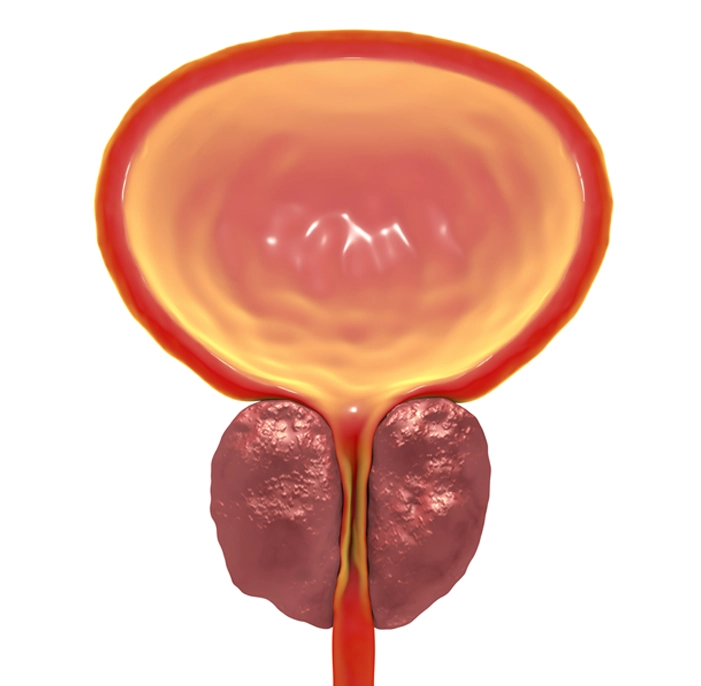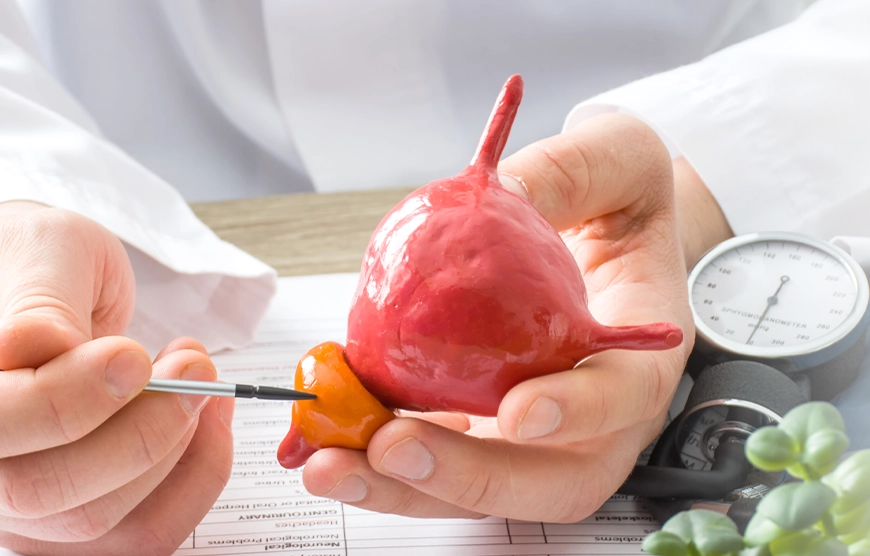What Is Benign Prostatic Hyperplasia (BPH)?
Benign Prostatic Hyperplasia (BPH), also known as an enlarged prostate, is a non-cancerous increase in the size of the prostate gland. This enlargement is commonly associated with ageing and may be influenced by hormonal changes. BPH does not increase the risk of developing prostate cancer. While the prostate enlarges, it is the extent to which it compresses the urethra that contributes to lower urinary tract symptoms (LUTS), such as difficulty initiating urination, weak stream, or increased urinary frequency and urgency.

What is a prostate?
A prostate is a walnut sized gland that lies above bladder and surrounds the urethra, the tube you pass urine from. The prostate makes ejaculatory fluid, the milky white fluid that makes up most of the ejaculate, and provides nourishment for the sperm.
Why do prostates enlarge with age?
The prostate tissue is very responsive to testosterone, the male hormone made in the testes. Testosterone stimulates the prostate glands to grow – as men usually don’t stop making testosterone as they get older, their prostates may continue to grow in size.
Why does an enlarged prostate affect urination?
The prostate is located under the bladder and surrounds the urethra. As it enlarges, it may compress the urethra leading to obstruction. The overall size of the prostate does not correlate to the degree of obstruction. More importantly, it is the degree of obstruction that is more likely to cause symptoms. This explains why a man with a smaller prostate may have worse symptoms than a man with a much larger prostate.
What are the symptoms of an enlarged prostate (BPH)?
What complications may occur if an enlarged prostate or BPH is left untreated?
How is an enlarged prostate or BPH diagnosed?
What treatments are available for an enlarged prostate (BPH)?
Lifestyle changes
Medications
Surgery for an enlarged prostate (BPH)
MIST (Minimally Invasive Surgical Treatments)

Urolift
This procedure involves passing a small camera into the urethra (cystoscope) and putting small
permanent implants into the prostate. These implants will lift, and hold, the obstructing prostate
tissue apart, increasing the width of the urethral passage. This reduces obstruction to the
urinary flow, improving the speed of the flow and reducing symptoms of an enlarged prostate or BPH.
This procedure is performed under local anaesthetic and sedation as a day surgery procedure, and
typically takes 5-10 minutes. Symptoms resolve soon after the surgery, and patients typically
return to normal activities by the next day.
Rezum Water Vapour Therapy

Rezum works by inserting sterile water vapor (steam) through a cystoscope, into the prostate gland during
a series of nine-second treatments. The therapy is targeted to a defined area because steam will travel
only between cells until it encounters natural barriers within the prostate.
When the steam contacts the prostate tissue, all the stored energy is released into the tissue. Over time,
the body absorbs the treated tissue, shrinking the prostate. With the extra tissue removed, the urethra
opens up, reducing BPH symptoms.
This procedure is performed under local anaesthetic and sedation as a day surgery procedure, and typically
takes 5-10 minutes. After the procedure, a urethral catheter is inserted for 5-14 days.
Prolieve
Prolieve is a catheter that is passed into the prostate part of the urethra, and combines using
focused Microwave Heating to destroy prostate tissue, together with a Pressurized Balloon to push
apart the prostate tissue. This creates a wider passage in the prostate for urine to flow through.
The treatment takes 45-minutes, and is can be performed under local anesthesia.

All 3 MISTs can effectively relieve BPH symptoms while preserving sexual function. Most men see
improvement in their symptoms within a few weeks and can return to regular activities within a few days
after the treatment.
However, there are selection criteria for these treatments. The choice of MIST needs to be individualised,
and carefully selected by the treating urologist, based on the size and configuration of the patient’s
prostate.

Surgical treatments for BPH requiring hospital admission and general/spinal anaesthesia
Not all prostates can be treated by MIST. Very large prostates or men who have complications from BPH such as urinary retention (complete inability to pass urine), bladder stones, or blocked kidneys, need surgery that can treat larger volumes of prostate tissue.
Transurethral Resection of the Prostate (TURP)
TURP is the standard operation for BPH and has been in use for over 40 years. It uses an
electrical wire loop to cut away the inside of the prostate into strips.
Transurethral resection of the prostate (TURP) is the most common surgical treatment for BPH, and
remains the gold standard upon which other surgical treatments are compared to. In a TURP, the
urologist inserts an instrument called a resectoscope through the tip of your penis and into the
urethra. The resectoscope helps your doctor see and trim away excess prostate tissue that's
blocking urine flow. After which a urinary catheter is inserted for 1-2 days. TURP is performed
under general or spinal anesthesia, and patient need to stay in hospital for 1-3 days.
Greenlight Laser Therapy / Prostatectomy
This technique uses a green coloured laser to vaporise the inside of the prostate, creating a
channel to improve urine flow. It is best suited for small to medium sized prostates, or in
patients who are on blood thinners.
Greenlight laser therapy involves using a laser fibre through a cystoscope to heat up and
vapourise obstructing prostate tissue. This unblocks the urethra and restores normal urine flow
from the bladder. This procedure is performed under general or spinal anaesthesia, and can be done
as a day surgery or an overnight stay, and recovery is generally quick.
The advantage of Greenlight Laser over the TURP is better control of bleeding, and is especially
useful for men who are on blood thinners for heart attack/stroke prevention.
Do note that Greenlight Laser Therapy, and TURP may have side effects that include retrograde
ejaculation and erectile dysfunction.
When should you see a prostate enlargement specialist?
If you find yourself displaying any of these symptoms, consult a urologist and get yourself checked out.
It is important to understand that while these urinary symptoms are more common with aging, they should
not be regarded as a normal part of life. Men should be evaluated to rule out more sinister causes of
urinary symptoms.
Men do not need to suffer from urinary symptoms of BPH. There are many treatment options available, and a
urologist can help men find the best treatment for their individual needs, and improve their quality of
life.







